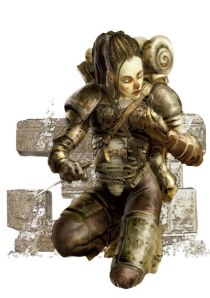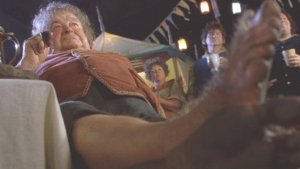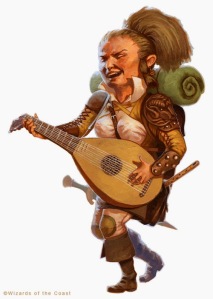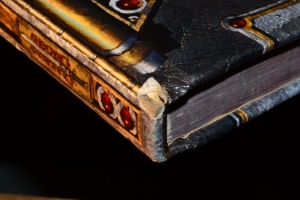Here it is, ladies and gentlemen, step right up, finally your favorite RPG blogger (I am your favorite, right?) will get around to reviewing the new edition of D&D, and specifically the Player’s Handbook!
Strap in kids, this is gonna be a long one!
Let me begin by saying that I approached 5e with the expectation that I would not like it. I’ve said this several times before, but my introduction to D&D was 3.5, and in my mind that has been the definitive, correct version. I could give a list of reasons I didn’t like fourth edition, but they all boil down to dammit, it’s different from 3.5! That makes it wrong!
Well folks, I like fifth edition! I think it’s a nice blend of what made 3.5 great and what they were trying to accomplish in 4e; or to put it another way, they’ve achieved the streamlining and accessibility they were trying to achieve in 4e while still achieving a very 3e feel to everything.
In thinking about how to do this review, I considered a few different approaches; chapter by chapter, individual mechanics, etc. I think what I’ll do is break this down into things I like, things I’m not sure about, and things I don’t like (no system is perfect, after all). Being the negative Nelly that I am, I’m going to start with…
Things I Don’t Like
Skills and Proficiencies
I won’t go into to much detail, because a) I’ve already talked about it, and b) I don’t dislike this as much as I did when I first perused the basic rules document, but I’m less than thrilled with how skills are being handled. It’s not really for practical reasons, but for personal taste. A friend of mine and I have an ongoing debate about the importance of skills; my point is that a long, diverse and detailed lists of skills is important in customizing a character, making making your 5th level rouge different mechanically from every other 5th level rouge. My friend’s point is that no game system can account for single thing that a character might ever do, and that having a long list of skills makes a system needlessly complicated, so it’s better to have fewer but more flexible traits. This debate of ours is like XTC Vs. Adam Ant: neither side is better than the other, we’re just approaching the question from different perspectives.
The 5e approach to skills is on my friend’s side. Skills (and there aren’t many of them) are just specific uses of ability checks. Characters have a proficiency bonus based on their character level, and gain proficiencies from race, class, and background on skills, saves, tools and weapons. When you’re making an attack with a proficient weapon, using a proficient tool, making a save with proficiency, casting a spell or making an ability check in which a skill proficiency applies, you get to add your proficiency bonus. This makes the system more flexible and easy to understand. From a practical viewpoint it works great. If you’re like me though, you might think the system is a little confining in your options during character creation and advancement. Content versus form. There is no right or wrong.
Feats
In 3.5, and in fact most other systems I’ve played (including terrible ones with broken systems like Doctor Who: Adventures in Time and Space), the system gives you a small number of special traits that give you bonuses or unique abilities to further set you apart from other characters, specifically in a way that makes them more awesome, like ambidexterity, extra hit points, special senses, etc. In some games their simply called Traits or Advantages, World of Darkness calls them Merits, and in D&D their called Feats.
Well, I got bad news, Feat lovers, but Feats are now an optional rules variant that come at the cost of an Ability Increase (which, incidentally, is now a function of class level instead of character level, but more on that later.)
Halflings
Halflings are my favorite D&D race. In the two games I’ve played that lasted more than a session or two I played Halflings, and in both games my fellow players kept teasing me about being a Hobbit.
But Halflings are not Hobbits. It’s not just that they’re from different settings, there are key differences. In short, this is a Halfling:
… and this is a Hobbit:
Pretty clearly not the same race, right? Yeah well…
Most of the images of Halflings in the new PHB have them looking distinctly Hobbit-like; that is, fat and/or jolly, singing and drinking and not acting like the stealthy rogue favoring race they’re supposed to be. I know, it’s just the art work, they haven’t made Halflings more Hobbit-like mechanically, but still, I don’t like it.
Racial Ability Score Penalties
There aren’t any! So races are good at different things, but there aren’t any races that are bad at stuff? Dwarves aren’t dinged on Charisma from being all secluded in their mountain kingdoms? Elves don’t take a hit on Strength from their light frames? Most folks probably wouldn’t see this as a negative thing, but it just makes sense to me that if you can have bonuses from your race, you should also be able to have penalties.
Things I’m Not Sure About
Advantage and Disadvantage
This is an interesting new mechanic, but until I’ve actually gotten to play a 5e game and see it in action, I’m not sure what to think about it.
Some situations give you either advantage or disadvantage on a check, save or attack. When you have either you roll two d20s instead of one. With advantage, you use the higher die, and with disadvantage the lower.
The thing that’s got me scratching my head is I can’t really see how this affects the outcome. Does this really make success in an action more or less likely? I mean, imagine that you have advantage or disadvantage on a check with a DC of 15, and both dice come up 16 or higher. Did having advantage really help you? Did disadvantage hurt you? The result is the same regardless of which die you use. Alternatively, if one die is a success and the other a failure, than does having advantage do more than give you a (I think probably) false sense of having dodged a bullet, and does disadvantage only serve to make the failure more annoying? I’m sure someone who knows more than I do about probability math can see what, if any, effects this might have, but for the time being I’m not sure if I consider this new mechanic a good or bad thing. (By the way, if you can clear this up for me, please do so in comments.)
Update
I just found this by a guy who knows stuff about probability, and according to him advantage and disadvantage make significant differences in check results. He’s even got graphs and shit. So I guess we’ll count it as a good thing.
Odd Numbered Racial Ability Score Adjustments
Some of the bonuses to ability scores granted by race are +1 instead of +2. That’s strange to me. Ability scores are usually (though not always) the part of the ability that matters least; what really matters is the modifier it grants, and those modifiers increase on even numbered scores (-1 at 8, +0 and 10, +1 at 12, etc.). Because of that, I think odd numbered adjustments are kind of pointless. For example, if you’re playing a Drow, and as such get a +1 to your Charisma score, and the number you rolled, picked, or purchased (depending on the method your DM is having you use) is 12, that increase from 12 to 13 doesn’t change the modifier and is therefore not all that helpful. Yes, I understand that gets you one step closer to 14, and thus a higher modifier, but I’ve always thought that racial score adjustments should always be even numbered so that they always change the modifier.
That being said, I do like that Humans, instead of having no ability adjustments (as in 3.5), get a +1 in all six abilities, so over all I can’t say I solidly like or dislike the odd numbered adjustments.
Things I Like
Combat
The combat chapter in the 3.5 PHB was 57 pages. In the 4e book, it was 31 pages. In the 5e book?
Nine. Nine pages. That’s it. Nine!
That ought to give you an idea of how streamlined and straightforward combat is in the new system. Sure, it’s more abstract and less realistic, but I’ll happily trade that for not having to spend 20 minutes figuring out the outcome of a grapple, or explaining to players how opportunity attacks work. It’s all easy and understandable. The pointy end goes in the other man.
Also, it leaves things more in the DMs hands than in the system, which is always a good thing. Right?
Ability Score Improvement
In the new rules, ability score increases (now called improvements) are granted by class level instead of character level, as in 3.5. At first glance this seems like a positive, but then I had a thought and looked at the Score Improvements for each class. Lo and behold, they happen at the same levels (4th, 12th, 16th, and 19th) for every class except for Fighters, who also get one at 6th, 8th and 14th level. So why make it a function of class? Why not keep it a function of character level (the way proficiency bonuses are) and make a Fighter class feature that gives extra improvements at 6th, 8th and 14th level? Is this, in fact, a pointless change?
Then I realized the benefits to a multi class character! If you have 4 levels in two classes, you get two ability score improvments (three if one of those classes is Fighter) when a single class character would only have one. So yeah, it’s a good thing after all!
3e Style Classes and Spell Casting
This, more than maybe anything else, is what earns 5e it’s official Spelunking RPGs seal of approval, because one of my biggest complaints about 4e was the way spells worked; specifically that they worked the same way as non magical effects. I really believe that the mechanics of magic should be different from other kinds of actions. Furthermore, the whole idea of having the special abilities of every class work the same way just seemed weird to me, and was probably the clearest indicator that 4e was trying to cash in on the popularity of MMOs.
Now, instead of the at will, per turn, per encounter and per day powers from 4e, classes are structured in a very third edition-like way, and the mechanics for spell casting are almost identical, though in both cases things have been cleaned up and made more understandable. It’s good! It’s really, really good!
The Artwork
It kicks ass (except for the way they’re depicting Halflings). Seriously, it’s a beautiful book.
The Disclaimer
From the copyright page:
“Disclaimer: Wizards of the Coast is not responsible for the consequences of splitting the party, sticking appendages in the mouth of a leering green devil face, accepting a dinner invitation from bugbears, storming the feast hall of a hill giant, angering a dragon of any variety, or saying yes when the DM asks, ‘Are you really sure?'”
Summary
I was going to go into more individual points but I’m already at about 1900 words on this thing and I’m sure neither of us wants to be here all day, so I’ll wrap it up. The fifth edition of Dungeons and Dragons combines the style and format of third edition with the accessibility of fourth edition, capturing the best of both worlds. I like it a lot, despite the few complaints I have, and I think I’m actually ready to accept it as my new difinitive version. I eagerly await the realease of both the Monster Maual later this month, and the DM Guide next month, and will probably be doing reviews of those books too.














